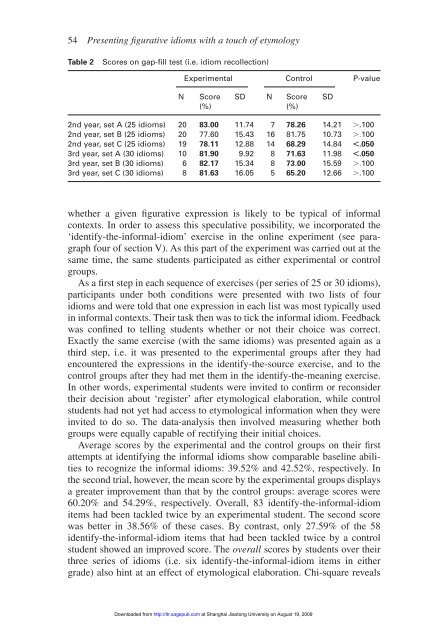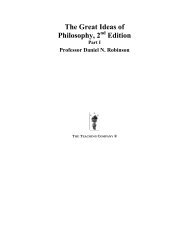Language Teaching Research
Language Teaching Research
Language Teaching Research
Create successful ePaper yourself
Turn your PDF publications into a flip-book with our unique Google optimized e-Paper software.
54 Presenting figurative idioms with a touch of etymology<br />
Table 2 Scores on gap-fill test (i.e. idiom recollection)<br />
Experimental Control P-value<br />
N Score SD N Score SD<br />
(%) (%)<br />
2nd year, set A (25 idioms) 20 83.00 11.74 7 78.26 14.21 .100<br />
2nd year, set B (25 idioms) 20 77.60 15.43 16 81.75 10.73 .100<br />
2nd year, set C (25 idioms) 19 78.11 12.88 14 68.29 14.84 .050<br />
3rd year, set A (30 idioms) 10 81.90 9.92 8 71.63 11.98 .050<br />
3rd year, set B (30 idioms) 6 82.17 15.34 8 73.00 15.59 .100<br />
3rd year, set C (30 idioms) 8 81.63 16.05 5 65.20 12.66 .100<br />
whether a given figurative expression is likely to be typical of informal<br />
contexts. In order to assess this speculative possibility, we incorporated the<br />
‘identify-the-informal-idiom’ exercise in the online experiment (see paragraph<br />
four of section V). As this part of the experiment was carried out at the<br />
same time, the same students participated as either experimental or control<br />
groups.<br />
As a first step in each sequence of exercises (per series of 25 or 30 idioms),<br />
participants under both conditions were presented with two lists of four<br />
idioms and were told that one expression in each list was most typically used<br />
in informal contexts. Their task then was to tick the informal idiom. Feedback<br />
was confined to telling students whether or not their choice was correct.<br />
Exactly the same exercise (with the same idioms) was presented again as a<br />
third step, i.e. it was presented to the experimental groups after they had<br />
encountered the expressions in the identify-the-source exercise, and to the<br />
control groups after they had met them in the identify-the-meaning exercise.<br />
In other words, experimental students were invited to confirm or reconsider<br />
their decision about ‘register’ after etymological elaboration, while control<br />
students had not yet had access to etymological information when they were<br />
invited to do so. The data-analysis then involved measuring whether both<br />
groups were equally capable of rectifying their initial choices.<br />
Average scores by the experimental and the control groups on their first<br />
attempts at identifying the informal idioms show comparable baseline abilities<br />
to recognize the informal idioms: 39.52% and 42.52%, respectively. In<br />
the second trial, however, the mean score by the experimental groups displays<br />
a greater improvement than that by the control groups: average scores were<br />
60.20% and 54.29%, respectively. Overall, 83 identify-the-informal-idiom<br />
items had been tackled twice by an experimental student. The second score<br />
was better in 38.56% of these cases. By contrast, only 27.59% of the 58<br />
identify-the-informal-idiom items that had been tackled twice by a control<br />
student showed an improved score. The overall scores by students over their<br />
three series of idioms (i.e. six identify-the-informal-idiom items in either<br />
grade) also hint at an effect of etymological elaboration. Chi-square reveals<br />
Downloaded from<br />
http://ltr.sagepub.com at Shanghai Jiaotong University on August 19, 2009














